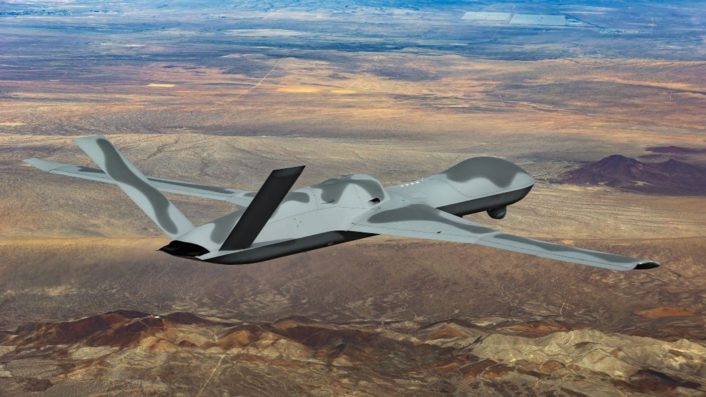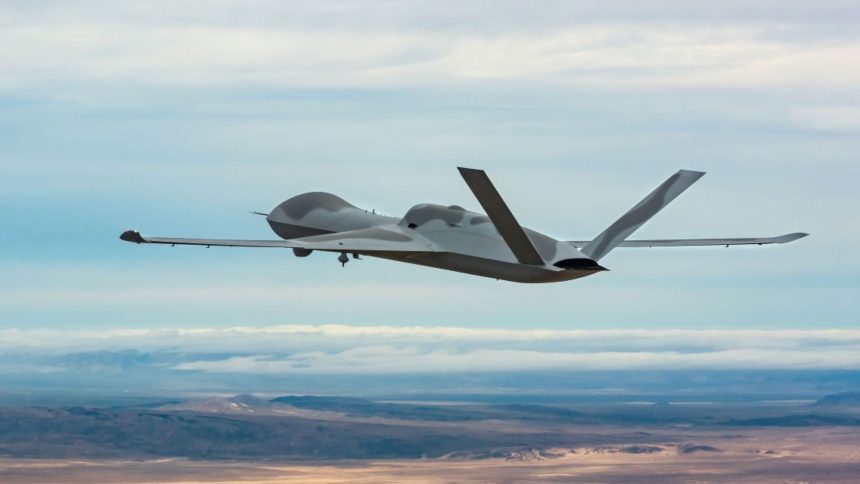The second test of the MQ-20 Avenger with Shield AI’s autonomy software saw the UCAV conducting more complex missions with both live and virtual aircraft.
A “first-of-its-kind” test of a General Atomics-Aeronautical Systems, Inc (GA-ASI) MQ-20 Avenger using Shield AI’s Hivemind autonomy software program, conducted on Jun. 11, 2025, saw the Unmanned Combat Aerial Vehicle (UCAV) completing a “simulated autonomous shootdown,” a GA-ASI release said. During this second test, GA-ASI mentioned the MQ-20 Avenger was part of an “exercise involving multiple live and virtual aircraft,” with Shield AI adding that the UCAV’s digital twin was also involved.
In a previous series of tests, part of the Air Force Test Center’s all-domain test series called Orange Flag 25-1 at Edwards AFB, California, there was the demonstration of the Hivemind’s ability to control the MQ-20 autonomously. This was in addition to testing for the compatibility with U.S. government mandated software architecture and switching between the Hivemind and the state-owned system/program.
Shield AI’s Hivemind was also the same AI “pilot” or “agent” controlling the autonomous X-62A VISTA that flew former Secretary of the Air Force Frank Kendall in 2024.
GA-ASI completes first-of-its-kind test involving MQ-20 Avenger® and multiple aircraft that included a successful simulated autonomous shoot-down.https://t.co/D9w1vKpYsM#UAS #UCAV #PAS2025 #ParisAirShow pic.twitter.com/4IGnGnldIM
— General Atomics Aeronautical Systems, Inc (GA-ASI) (@GenAtomics_ASI) June 17, 2025
Shield AI in its statement describes Hivemind as an “AI-powered autonomy software” enabling “unmanned systems to conduct complex missions in GPS- and comms-denied environments,” through “modular integration, operator confidence, and multi-platform deployment.”
“Hivemind delivers mission autonomy with proven adaptability and tactical relevance,” the company’s statement said. Additional information on the type of tactical scenario, whether it was a pilotless target drone, how it was detected, its distance and bearing has not been mentioned by either company.
Mission autonomy. Live-virtual-constructive. Powered by Hivemind.
In our latest #MQ20 Avenger flight with @GenAtomics_ASI, Hivemind flew both the live #aircraft and its digital twin—executing real combat maneuvers in a live-virtual op.
“Readiness means flying today, not… pic.twitter.com/TcPIJZS54C
— Shield AI (@shieldaitech) June 17, 2025
February test
Shield differentiated between Feb. 2025’s first flight test of the Hivemind-enabled MQ-20 Avenger UCAV, during Orange Flag 25-1 exercise, and the June tests: “While the February flight focused on basic administrative tasks using a command-line interface (CLI), the June test demonstrated tactical skills such as formation flying and combat air patrol maneuvers, using A-GRA-compliant mission planning software.” This testing in “complex, LVC mission environments,” accelerates the “path to scalable, operational autonomy.”
About the latest test, Shield AI said Hivemind commanded and connected both a live MQ-20 and its digital twin “executing coordinated tasks across physical and virtual aircraft in a blended mission scenario.” This established the elementary teaming tactic in aerial warfare, where one platform detects a threat while the other engages it. Shield AI also said the “autonomy software connected seamlessly with C2 (Command and Control) and edge systems for real-time execution,” indicating manned ground control monitored the UCAV’s behaviour.

A feature of the earlier test, beside the successful demonstration of the Hivemind autonomy software, was also the MQ-20 Avenger flying with some mandated “Autonomy Government Reference Architecture (A-GRA)-compliant interfaces.” A-GRA is a Department of Defense (DoD) framework designed to enhance interoperability across autonomous military platforms, and future work will include “updates to achieve full A-GRA compliance and further strengthen cross-platform autonomy,” Shield AI’s release said at the time.
Another state-owned software that figured in the February test was the “government-provided autonomy software” (or “reference autonomy stack”) received by the MQ-20 Avenger, demonstrating “autonomous flight operation capabilities focused on conducting air-to-air engagements,” GA-ASI’s release said. The Shield AI stack, meanwhile, “demonstrated autonomy skills for safe administrative phases of flight.”
The flights proved that GA-ASI aircraft can “quickly go from company-written software, to government-provided, to other vendors’ software as needed.”
June test
The latest exercise saw the MQ-20 Autonomous Collaborative Aircraft demonstrating being able to “marshal; do dynamic midair station-keeping with several real aircraft; patrol a simulated combat area; make decisions autonomously; team with human command-and-control; and intercept two live aircraft autonomously – resulting in a simulated successful missile shot against the live targets.” The “live-on-live” event using representative Group 5 unmanned aerial vehicles (UAVs) proved how mature autonomy is today for future platforms.
Autonomous flight – delivered at record speed. Through rapid development and integration, GA-ASI continues to prove speed to flight during a recent demonstration of @ShieldAItech AI-powered autonomy software aboard our MQ-20 Avenger®.
Learn more: https://t.co/d4F20WVnE8 pic.twitter.com/AALMWFqitJ
— General Atomics Aeronautical Systems, Inc (GA-ASI) (@GenAtomics_ASI) March 4, 2025
In a video showing the company-owned MQ-20 Avenger, tail number N903PC, technical program manager Abigail Francis said that the live MQ-20 didn’t know the virtual MQ-20 wasn’t real.
“This event reflects the kind of interoperability and adaptability we believe is essential for future autonomy efforts,” said Michael Atwood, Vice President of Advanced Programs at GA-ASI. “Being able to rapidly integrate and test autonomy elements from multiple vendors helps ensure the most effective capabilities are available to the warfighter, regardless of origin.”
The Jun. 11 test also saw the MQ-20 Avenger conducting a “mid-flight transition” from the government-provided suite of software to Hivemind for “a similar mission profile […] without affecting aircraft stability or mission continuity.” Beside demonstrating how standardized reference architectures “are streamlining hardware and software integration, even from different vendors,” this also “allows the government to incorporate capabilities from a broad vendor ecosystem without being tied to any single supplier,” the GA-ASI release said.
Vice president of Hivemind Solutions Christian Gutierrez said in a company release: “We’re lowering the risk for fielded autonomy and proving that scalable, mission-ready autonomy is already here.”
GA-ASI is at the forefront of advancing autonomy. The #GambitUAS series of uncrewed collaborative aircraft are modular, tailorable and affordable. Enabled by our expertise in software, control systems and human-machine interfaces, there’s a variant for every mission.… pic.twitter.com/4IfO9GA3li
— General Atomics Aeronautical Systems, Inc (GA-ASI) (@GenAtomics_ASI) June 17, 2025
Tactical use
The autonomy for complex missions such as an air-to-air role is also concurrent with the U.S. Air Force moving to incorporate Collaborative Combat Aircraft (CCA) in its fleet, with GA-ASI’s YFQ-42A being one of two chosen models, and the other being Anduril’s YFQ-44A. The collaboration with Shield AI can certainly be considered a parallel effort to refine autonomy software while CCAs begin test flights. GA-ASI has already described Avenger as “a jet-powered UAS used extensively as a test bed for future Autonomous Collaborative Platforms.”
Depending upon how the CCA performs and the results drawn by the USAF, the Hivemind software can be installed onto the existing YFQ-42A, or the Increment 2 designs. Many air-to-air situations do not involve complex decision-making requiring sentient and contextual reasoning.

Scenarios like enforcing air denial that need merely firing an AAM onto a hostile target, differentiated by an unfamiliar radar signature and possibly negative indications on an Identification Friend or Foe (IFF) interrogations, can easily be undertaken by UAVs. This becomes even more viable if the air force has other supporting assets like Generation 4, 4.5 and 5 aircraft, Airborne Early Warning and Control (AEW&C) and satellites.









